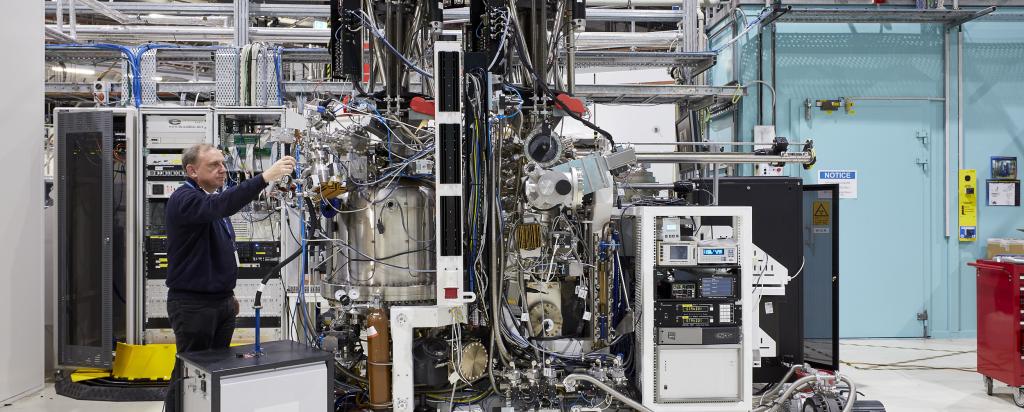
Soft x-ray spectroscopy
Introduction
Soft X-rays are generally understood to be X-rays in the energy range of 100-3,000 eV. They have insufficient energy to penetrate the beryllium window of a hard x-ray beamline but have energies higher than that of extreme ultraviolet light. Soft x-rays cover an energy range of importance for spectroscopic studies of many elements in the periodic table. They are well suited to characterising surfaces and near-surface interfacial layers.
The soft x-ray beamline consists of two branchlines; The Imaging branchline and The Spectroscopy branchline. Since both branchlines have a common undulator and monochromator only one branch can operate at any given time. The spectroscopy branchline is set up primarily for X-ray Absorption Spectroscopy (XAS) of low atomic number elements, X-ray Photoelectron Spectroscopy (XPS) and Angle-Resolved Photoelectron Spectroscopy (ARPES) all of which are performed under Ultra-High Vacuum (UHV) conditions. The Imaging branchline allows for Coherent Diffraction Imaging (CDI) and ptycocraphy.
The Soft X-ray beamline currently features 3 endstations; a Coherent Diffraction Imaging (CDI) endstation permanently attached to the end of the imaging branch, as well as a Prevac XAS/XPS endstation and an ARPES endstation with a toroidal geometry designed detector, which both take turns at being attached to the spectroscopy branch. The CDI endstation is owned and operated by La Trobe University, for information on this endstation and its capabilities please contact Dr Grant van Riessen (G.vanRiessen@latrobe.edu.au). Recently, a new experimental chamber has been commissioned upstream on the Imaging branch. This inline system is a high-throughput Near Edge X-ray Absorption Spectroscopy (NEXAFS) chamber, which allow for measurement of samples at a pressure of 10-6 mbar instead of 10-10 mbar, the UHV pressure needed to measure samples in the Prevac or Toroidal endstations.
The photon range of the beamline encompasses the NEXAFS K edges of C, O and N at high resolution >10,000. The collection of core level NEXAFS and high resolution photoelectron spectroscopy are key elements in the study of (bio)organic systems.Synchrotron soft x-ray spectroscopy provides distinctive information for numerous research areas ranging from fundamental studies in solid state physics and nanotechnology to applied chemical problems in catalysis and organic electronics.
Scientific Applications
Earth and environmental sciences
Synchrotron soft x-ray techniques are already opening up new ways to address the complex problems arising from earth resource utilisation, and this contribution is expected to increase in areas such as environmentally sustainable ore extraction, mineral processing, coal combustion and soil use.
The surface chemistry of metal sulfides is of major importance in the separation of the valuable and unwanted components in base metal ores, in the hydrometallurgical processing of a concentrate to produce the corresponding metal from the sulfide, and in the leaching of rejected material in waste heaps. Since the application of synchrotron XPS to mineral fracture surfaces, the importance of surface chemical states arising from relaxation of the outermost layer following fracture has become evident.
The enhanced surface sensitivity provided by synchrotron XPS, as well as the ability of angle-dependent x-ray absorption near edge structure (XANES) to reveal orientation, have also assisted elucidation of the mechanism by which flotation reagents interact with the surface of minerals.
Determination of the chemical forms of heteroatoms, such as nitrogen, in a large molecular weight or complex material such as coal is a case where soft x-ray absorption spectroscopy is used to complement conventional XPS for low atomic number non-surface chemical characterisation. This information is sought in research to minimise the generation of undesirable species such as NOx in coal combustion.
Advanced materials
A niche area in which Australia has been successful to date is the development of thin film materials for electronic and optoelectronic devices. Thin films of materials with particular chemical and/or physical properties such as piezoelectricity are typically deposited onto an appropriate substrate by one form of chemical vapour deposition, and during the development phase for both precursor and deposition conditions, the physical and chemical properties of the film must be determined. Variable-angle XAS from a synchrotron source can augment initial conventional XPS analysis to reveal the orientation of film crystallites.









